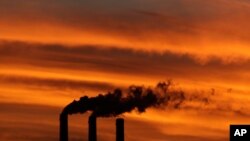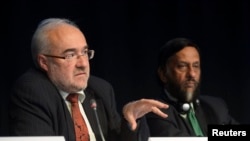GENEVA —
The World Meteorological Organization reports the amount of carbon dioxide and other greenhouse gases in Earth's atmosphere reached a record high in 2012. This accelerating trend will have devastating consequences on climate change, the U.N. agency says, unless the world's nations do more to to rein in emissions.
WMO reports the warming effect on the Earth’s climate has risen by nearly one-third since 1990. This is mainly due to atmospheric levels of carbon dioxide and other heat-trapping gases, such as methane and nitrous oxide.
The agency’s annual Greenhouse Gas Bulletin notes that fossil fuel-related emissions, mainly from carbon dioxide, account for 80 percent of the increase in warming. It says CO2 (the English chemical formula for carbon dioxide) concentrations in the atmosphere grew more rapidly last year than the average growth rate over the past decade.
WMO Secretary-General Michel Jarraud says the increase of carbon dioxide is mostly due to human activity - industry, energy production, land use and deforestation, among other factors.
“CO2 is a very stable gas, so it means that there is no sort of chemical reaction which would naturally destroy CO2 [in] the atmosphere. So it stays for very long periods - hundreds of years, or even more. And that is why, as a consequence, the actions we take now or the actions we do not take now will have consequences for a very, very long period,” said Jarraud.
WMO says methane is the second biggest contributor to greenhouse gas and to the potential warming of the atmosphere. About 40 percent of methane reaches the atmosphere from natural sources, such as wetlands and termites. The other 60 percent comes from human activities including cattle breeding, rice agriculture, fossil fuel exploitation and biomass burning.
Nitrous oxide is the third most important greenhouse gas. WMO says about 60 percent of emissions come from natural sources and 40 percent from human activity. The U.N. agency notes nitrous oxide also plays an important role in the destruction of the atmosphere's ozone layer, which protects people from the harmful ultraviolet rays of the sun.
In its recent report, the Intergovernmental Panel on Climate Change confirmed that atmospheric concentrations of CO2, methane and nitrous oxide are breaking all records, and are now higher than they have been for more than 800,000 years.
WMO Secretary-General Jarraud says this is causing the climate to change in many worrisome ways.
“We are worried not only about the impact on temperature, which is important, but also the impact on the water cycle - more droughts, more floods in other parts of the world. We are worried about the impact on a number of extreme weather events. We are worried about the impact on the sea level,” he said.
Jarraud warns global average temperatures may be 4.6 degrees higher than pre-industrial levels by the end of this century if the world carries on with “business as usual.” This, he says, would have devastating consequences for future generations.
The longer nations wait to strengthen controls on greenhouse-gas emissions, Jarraud says, the more difficult it will be to keep temperatures from rising above the two-degree Celsius limit that countries have agreed.
Even if the world acts now and emissions of CO2 are stopped immediately, he says most aspects of climate change will persist for centuries.
WMO reports the warming effect on the Earth’s climate has risen by nearly one-third since 1990. This is mainly due to atmospheric levels of carbon dioxide and other heat-trapping gases, such as methane and nitrous oxide.
The agency’s annual Greenhouse Gas Bulletin notes that fossil fuel-related emissions, mainly from carbon dioxide, account for 80 percent of the increase in warming. It says CO2 (the English chemical formula for carbon dioxide) concentrations in the atmosphere grew more rapidly last year than the average growth rate over the past decade.
WMO Secretary-General Michel Jarraud says the increase of carbon dioxide is mostly due to human activity - industry, energy production, land use and deforestation, among other factors.
“CO2 is a very stable gas, so it means that there is no sort of chemical reaction which would naturally destroy CO2 [in] the atmosphere. So it stays for very long periods - hundreds of years, or even more. And that is why, as a consequence, the actions we take now or the actions we do not take now will have consequences for a very, very long period,” said Jarraud.
WMO says methane is the second biggest contributor to greenhouse gas and to the potential warming of the atmosphere. About 40 percent of methane reaches the atmosphere from natural sources, such as wetlands and termites. The other 60 percent comes from human activities including cattle breeding, rice agriculture, fossil fuel exploitation and biomass burning.
Nitrous oxide is the third most important greenhouse gas. WMO says about 60 percent of emissions come from natural sources and 40 percent from human activity. The U.N. agency notes nitrous oxide also plays an important role in the destruction of the atmosphere's ozone layer, which protects people from the harmful ultraviolet rays of the sun.
In its recent report, the Intergovernmental Panel on Climate Change confirmed that atmospheric concentrations of CO2, methane and nitrous oxide are breaking all records, and are now higher than they have been for more than 800,000 years.
WMO Secretary-General Jarraud says this is causing the climate to change in many worrisome ways.
“We are worried not only about the impact on temperature, which is important, but also the impact on the water cycle - more droughts, more floods in other parts of the world. We are worried about the impact on a number of extreme weather events. We are worried about the impact on the sea level,” he said.
Jarraud warns global average temperatures may be 4.6 degrees higher than pre-industrial levels by the end of this century if the world carries on with “business as usual.” This, he says, would have devastating consequences for future generations.
The longer nations wait to strengthen controls on greenhouse-gas emissions, Jarraud says, the more difficult it will be to keep temperatures from rising above the two-degree Celsius limit that countries have agreed.
Even if the world acts now and emissions of CO2 are stopped immediately, he says most aspects of climate change will persist for centuries.













